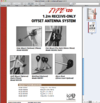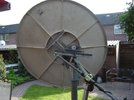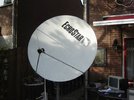I've been doing a bit of research

The gain on the CM 1.2m is stated as 42dBi @ 11.95 GHz (/
http://www.skywareglobal.com/images/pdf/Prod.sheets 2012/Receive_Only/Type_120_VSR004.3.pdf)
The gain for the Fibo 1.2m is stated as 42.4dBi @ 11.7GHz (/
http://www.satellite-calculations.com/Fibo/fibo.htm)
Looks like there is not a lot in it to me.
Also the CM 1.2m is 121cm x 132cm (my measurements), the Fibo is 120cm x 135cm (same source as above)
Yet again, not a lot in it!
The actual experienced gain depends on a range of other physical factors.
Including:
1) Illumination of the dish. The physical size of the dish is less relevant than the illuminated size of the dish (see RimanTSS detailed explorations elsewhere on this site for context). The illuminated size is smaller than the physical size, and will typically be an oval-ish portion of the entire dish, save a centimeter or two around the edges. Therefore you can't really compare the physical sizes of two dishes without knowing what part of the dish we are talking about. This depends on the "beam-width" of the LNB (roughly f/D ratio), and the accuracy of the placement of the LNB in the focal point (sweet spot) of the dish. This leads to:
2) Accuracy of LNB positioning. I.e. how well is the LNB chosen positioned when locked in the grip of the provided LNB holder?
This all depends on the mounting mechanics, and stability of the components used for the mount etc.
On larger (and often older) dishes, the LNB mount is designed to hold a specific feed-horn, ensuring a resonable good alignment of feed-horn, LNB and reflector. This is what people are trying to optimise when they go in search of original feed-horns etc.
In the end, a 1.2m high-quality shaped dish will perform as another 1.2m high-quality shaped dish, when it comes to gain, or *signal strength*.
Then there is the matter of signal quality, which is a different kettle of fish. Signal quality depends on noise floor of the LNB electronics, the background noise seeping into the feed-horn, the polarisation dispersion introduced by the reflector, any signal distortion introduced in calbles, connectors, amplifiers etc (if used at all), and of course non-linear issues like irradiated noise (DECT phones, microwaves etc) before the signal gets to the analogue-to-digital converter of the STB. Plus a range of other stuff.
But there is (of course) a link between size and quality, in that signal quality is usually easier to get from a high-gain dish than a lower gain dish. Thus, a 1.8m dish gives better results than a 1.2m one when boh are aimed correctly.
I tend to agree wth RimanTSS and others here, it really comes down to a hands-on comparison.






